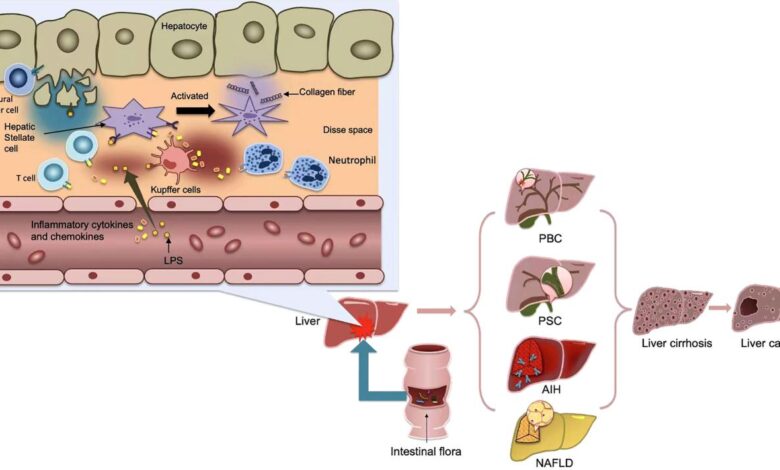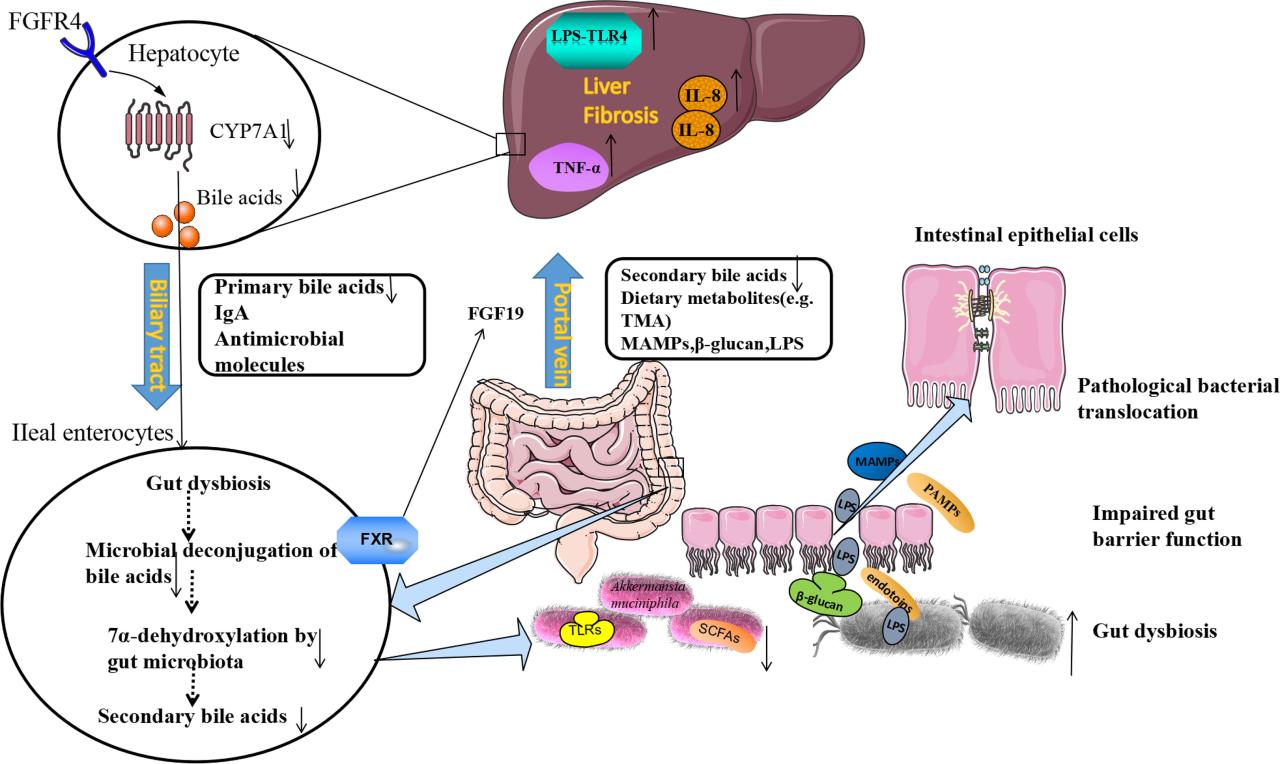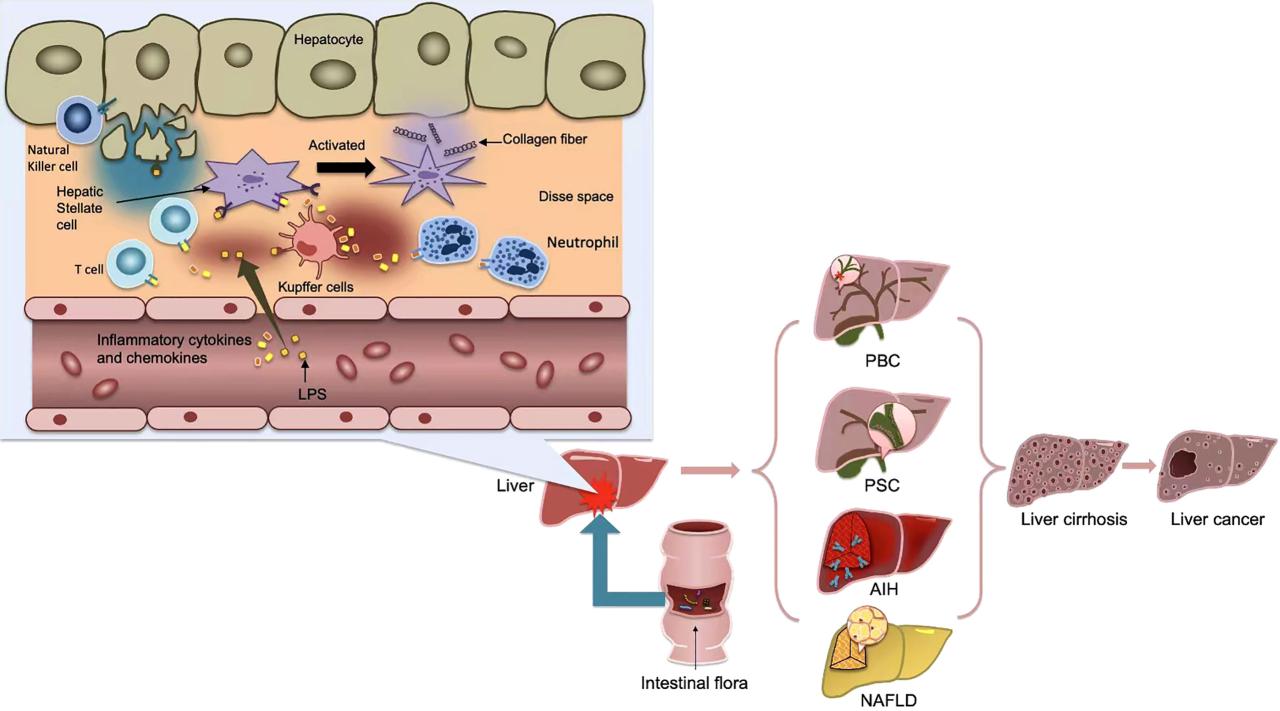
Gut bacteria liver damage is a complex interplay between the microorganisms residing in our gut and the health of our liver. These tiny inhabitants, while crucial for digestion and overall well-being, can sometimes contribute to liver dysfunction. This exploration delves into the intricate relationship, examining the mechanisms behind potential damage, different types of liver issues, influencing factors, and preventive strategies.
We’ll also touch upon current research and future directions in this field.
The liver, our vital filter and processing center, plays a critical role in detoxification and metabolism. Gut bacteria, through various mechanisms, can impact the liver’s function, leading to a cascade of potential complications. This blog post breaks down the science behind this connection, highlighting the bidirectional communication between these two crucial systems.
Introduction to Gut Bacteria and Liver Function
Our gut, a complex ecosystem teeming with trillions of bacteria, plays a crucial role in our overall health. These gut microbes, collectively known as the gut microbiota, aren’t just passengers; they actively participate in digestion, nutrient absorption, and immune system development. Their impact extends far beyond the digestive tract, influencing various bodily functions, including liver health. The liver, the body’s largest internal organ, is responsible for a vast array of vital functions, from filtering toxins to producing essential proteins.
A healthy relationship exists between these two crucial components, where gut bacteria can influence liver function, and vice-versa. This bidirectional communication is essential for maintaining overall well-being.The liver, a metabolic powerhouse, processes nutrients, detoxifies harmful substances, and synthesizes essential proteins. It plays a critical role in regulating cholesterol levels, blood sugar, and bile production. A disruption in this delicate balance can lead to a cascade of health issues.
The intricate relationship between gut bacteria and liver health is a burgeoning area of research, revealing the profound impact of gut microbiota on liver function.
The Role of Gut Bacteria in Overall Health
Gut bacteria are essential for a healthy digestive system, contributing to the breakdown of food and nutrient absorption. They also play a key role in the development and function of the immune system, protecting against pathogens and promoting tolerance. The diversity and abundance of gut bacteria are directly correlated with overall health. Imbalances in the gut microbiota can lead to various health problems, including digestive issues, immune disorders, and even metabolic diseases.
Normal Function of the Liver in the Human Body
The liver’s diverse functions are essential for maintaining homeostasis. It filters blood, removing toxins and waste products. It produces bile, crucial for fat digestion. The liver also synthesizes proteins, crucial for blood clotting and other bodily functions. Furthermore, the liver plays a key role in carbohydrate metabolism, regulating blood sugar levels.
Its role in cholesterol metabolism is also vital, helping to maintain healthy cholesterol levels.
Relationship Between Gut Bacteria and Liver Health
The relationship between gut bacteria and liver health is characterized by a bidirectional communication system. Gut bacteria can influence liver function through various mechanisms, including the production of metabolites and the modulation of immune responses. Conversely, the liver can influence the composition and function of the gut microbiota. This intricate interplay is essential for maintaining overall health.
Mechanisms by Which Gut Bacteria Influence Liver Function
Gut bacteria exert their influence on liver function through several pathways. These include the production of metabolites that can either benefit or harm the liver. Additionally, the modulation of immune responses can affect liver inflammation and damage.
| Bacteria Type | Function | Potential Impact on Liver |
|---|---|---|
| Bacteroides | Important in carbohydrate metabolism and bile acid processing. | Can influence bile acid metabolism and potentially impact liver health, both positively and negatively. |
| Firmicutes | Play a role in energy extraction from carbohydrates. | Potential impact on lipid metabolism and liver fat accumulation. |
| Bifidobacteria | Known for their beneficial effects on the immune system and production of short-chain fatty acids. | Can reduce inflammation and improve liver function by modulating the immune response and producing beneficial metabolites. |
| Lactobacilli | Known for their antimicrobial properties and production of various metabolites. | Potential to reduce inflammation and promote liver health. |
Mechanisms of Gut Bacteria-Liver Damage: Gut Bacteria Liver Damage
The intricate relationship between gut bacteria and liver health is a complex interplay. Dysbiosis, an imbalance in the gut microbiota, can significantly impact liver function, leading to various forms of liver damage. This often manifests as inflammation, oxidative stress, and metabolic disturbances. Understanding the specific mechanisms by which gut bacteria contribute to liver disease is crucial for developing targeted therapies and preventative strategies.
Specific Gut Bacteria and Their Impact
Gut bacteria, in their normal, healthy state, perform vital functions. However, specific types of bacteria, or imbalances in the community, can trigger inflammatory responses within the liver. These inflammatory responses can lead to progressive liver damage, ranging from mild to severe.
Pathways of Gut Bacteria-Induced Liver Inflammation
The mechanisms through which gut bacteria contribute to liver inflammation are multifaceted. One major pathway involves the production of inflammatory molecules by the gut bacteria themselves. These molecules can directly trigger an immune response in the liver, leading to the recruitment of inflammatory cells. Another pathway involves the disruption of the gut barrier, allowing bacteria or their products to leak into the bloodstream.
This translocation is a significant contributor to systemic inflammation, including liver inflammation.
The Role of Endotoxins
Endotoxins, components of the outer membrane of certain gram-negative bacteria, play a crucial role in mediating gut bacteria-liver damage. These toxins, when released into the bloodstream, trigger a strong inflammatory response. This response can cause liver cells to become damaged and dysfunctional. The inflammatory cascade initiated by endotoxins can also lead to oxidative stress, further contributing to liver injury.
Gut bacteria and liver damage are definitely a complex issue. It’s fascinating how, despite long-term treatment, HIV can persist in the spinal fluid, impacting cognitive function, as detailed in this article about despite long term treatment hiv persists in spinal fluid and is linked to cognition problems. This could potentially shed light on similar mechanisms influencing the gut-liver axis in the context of liver damage.
Perhaps the immune system’s response in both situations is related to the body’s overall inflammatory state. More research is needed to explore this further.
Metabolic Processes of Gut Bacteria
Gut bacteria engage in various metabolic processes that can influence liver function. For instance, certain bacteria produce metabolites that can disrupt normal liver metabolism. These metabolites can interfere with the liver’s ability to process nutrients and detoxify harmful substances. For example, some bacteria produce substances that increase the production of cholesterol or other lipids, contributing to fatty liver disease.
Furthermore, the metabolites produced by certain bacteria can affect the synthesis and excretion of bile acids, potentially leading to liver dysfunction.
Gut bacteria’s role in liver damage is fascinating, but it’s not isolated. Think about how obesity impacts the body; a recent study shows a strong link between obesity and respiratory issues, like asthma, where obesity narrows airways, leading to breathing problems. Obesity narrows airway leads to asthma. This interconnectedness highlights the complex ways our bodies react to imbalances, and how these issues can potentially affect the liver’s health through a variety of factors including gut bacteria.
It’s a reminder that even seemingly disparate health problems can be linked.
Comparative Effects of Different Gut Bacteria on the Liver
| Type of Gut Bacteria | Potential Mechanisms of Liver Damage | Examples |
|---|---|---|
| Escherichia coli (some strains) | Production of endotoxins, disruption of gut barrier, inflammatory response. | Certain strains of E. coli are associated with increased liver inflammation in animal models. |
| Bacteroides fragilis (some strains) | Production of inflammatory metabolites, disruption of gut barrier, endotoxemia. | Certain strains of B. fragilis have been linked to liver inflammation in clinical studies. |
| Clostridium species (some strains) | Production of toxins, dysbiosis, immune response activation. | Certain Clostridium species are implicated in various inflammatory conditions, potentially impacting the liver. |
Note: This table provides simplified examples. The complex interplay between gut bacteria and liver damage is not fully understood and requires further investigation.
Types of Liver Damage Associated with Gut Bacteria
Gut bacteria, while crucial for overall health, can sometimes contribute to liver damage. This damage can manifest in various forms, ranging from relatively mild conditions to severe and potentially life-threatening situations. Understanding the different types of liver damage, their progression, and the associated symptoms is vital for early diagnosis and appropriate management.
Recent research suggests a strong connection between gut bacteria imbalance and liver damage. A healthy gut microbiome is crucial, and one way to potentially support a thriving gut is through a paleo diet. Choosing the right paleo brands and products like best paleo brands and products can make a big difference. These products often prioritize whole foods, minimizing processed ingredients that could negatively impact gut health, ultimately reducing the risk of liver damage.
So, prioritizing gut health is vital for overall well-being.
Fatty Liver Disease
Fatty liver disease, or hepatic steatosis, is a condition characterized by the accumulation of excess fat in the liver cells. This buildup can be caused by various factors, including metabolic issues, genetics, and, in some cases, the dysbiosis of gut bacteria. Certain gut bacteria can produce metabolites that promote fat accumulation in the liver. This buildup can initially be asymptomatic, but if left unmanaged, it can progress to more serious forms of liver damage.
Hepatitis
Hepatitis refers to inflammation of the liver. Infectious hepatitis is often caused by viral infections, but gut bacteria can also play a role. Dysregulated gut microbiota can lead to the release of inflammatory molecules that trigger an immune response within the liver, causing inflammation. The severity of hepatitis can vary significantly, from mild and self-limiting to chronic conditions requiring long-term management.
Cirrhosis
Cirrhosis is a late-stage liver disease characterized by the replacement of healthy liver tissue with scar tissue. This scarring process, often the result of prolonged liver damage, can significantly impair the liver’s ability to function. Gut bacteria can contribute to this process through the production of toxins or metabolites that exacerbate liver damage over time. The progression of cirrhosis can be slow, and in many cases, it may not show noticeable symptoms until it has reached an advanced stage.
Symptoms and Diagnostic Methods
The symptoms of liver damage can vary depending on the specific condition and the stage of progression. Early stages often exhibit few or no symptoms. As the damage progresses, symptoms can include fatigue, abdominal pain, jaundice (yellowing of the skin and eyes), and swelling in the legs and abdomen. Diagnostic methods may include blood tests to assess liver enzyme levels, imaging techniques like ultrasound or CT scans, and liver biopsies to examine tissue samples.
Complications, Gut bacteria liver damage
Complications associated with liver damage can be serious. Fatty liver disease, if untreated, can progress to more severe forms of liver damage like cirrhosis or liver failure. Hepatitis, depending on the cause, can lead to chronic liver disease and potentially liver cancer. Cirrhosis, with its advanced scarring, can result in liver failure, requiring a liver transplant.
Table of Liver Damage Types
| Type of Liver Damage | Potential Causes (Related to Gut Bacteria) | Symptoms | Treatment Approaches |
|---|---|---|---|
| Fatty Liver Disease | Dysbiosis, production of metabolites promoting fat accumulation | Initially asymptomatic; later: fatigue, abdominal discomfort, jaundice | Lifestyle changes (diet, exercise), medications to address underlying conditions |
| Hepatitis | Dysregulated gut microbiota triggering inflammatory response | Fatigue, fever, abdominal pain, jaundice | Treatment for the underlying cause (viral infections), medications to reduce inflammation |
| Cirrhosis | Prolonged gut-bacteria-induced liver damage, production of toxins | Advanced stages: fatigue, jaundice, ascites (fluid buildup), encephalopathy | Management of complications, lifestyle changes, liver transplant in severe cases |
Factors Influencing Gut Bacteria and Liver Damage
Our gut bacteria, a complex community of microorganisms, play a vital role in digestion and overall health. However, imbalances in this community, known as dysbiosis, can negatively impact the liver, leading to various forms of damage. Understanding the factors that influence the composition and activity of gut bacteria is crucial for preventing and managing liver conditions.
Dietary Factors
Diet significantly influences the gut microbiota. A diet rich in processed foods, sugar, and unhealthy fats can promote the growth of harmful bacteria and lead to an imbalance. Conversely, a diet rich in fiber, fruits, and vegetables provides prebiotics, promoting the growth of beneficial bacteria. These dietary choices can directly affect the liver’s metabolic processes and susceptibility to damage.
For instance, a high-fat diet can contribute to fatty liver disease, while a fiber-rich diet can aid in regulating cholesterol levels and improving liver function.
Lifestyle Choices
Lifestyle factors like exercise and stress also impact gut bacteria. Regular physical activity has been shown to improve gut health by promoting the growth of beneficial bacteria and reducing inflammation. Conversely, chronic stress can disrupt the delicate balance of gut bacteria, potentially leading to dysbiosis and increasing the risk of liver damage. The effect of stress on the gut-liver axis is a complex area of research, but there is mounting evidence linking chronic stress to liver dysfunction.
Prebiotics and Probiotics
Prebiotics are non-digestible food ingredients that selectively stimulate the growth and activity of beneficial bacteria in the gut. Probiotics are live microorganisms that, when consumed in adequate amounts, confer a health benefit to the host. These substances can help restore the balance of gut bacteria and potentially improve liver function. Prebiotics and probiotics can potentially reduce inflammation and improve the liver’s detoxification capacity, although more research is needed to fully understand their impact on liver health in various conditions.
Medications and Drugs
Certain medications and drugs can have a profound effect on the gut microbiota. Antibiotics, for example, can kill beneficial bacteria alongside harmful ones, leading to dysbiosis. Other medications, such as nonsteroidal anti-inflammatory drugs (NSAIDs), may also negatively impact the gut microbiota and potentially contribute to liver damage. It is crucial to be aware of the potential impact of medications on gut bacteria and liver health, especially in individuals with pre-existing liver conditions.
Table: Factors Influencing Gut Bacteria and Liver Damage
| Factor | Effect on Gut Microbiota | Consequences for Liver |
|---|---|---|
| High-fat, processed food diet | Promotes growth of harmful bacteria, reduces beneficial bacteria | Increased risk of fatty liver disease, impaired metabolic function |
| Fiber-rich diet | Stimulates growth of beneficial bacteria | Improved regulation of cholesterol, better liver function |
| Regular exercise | Promotes beneficial bacteria, reduces inflammation | Improved gut health, reduced risk of liver damage |
| Chronic stress | Disrupts balance of gut bacteria, increases inflammation | Potential for liver dysfunction, increased susceptibility to damage |
| Antibiotics | Kills beneficial and harmful bacteria | Increased risk of dysbiosis, potential for liver damage |
| NSAIDs | May negatively impact gut microbiota | Potential for liver damage, especially in susceptible individuals |
| Prebiotics | Stimulate growth of beneficial bacteria | Potential to reduce inflammation, improve detoxification |
| Probiotics | Introduce live beneficial bacteria | Potential to restore balance, improve liver function |
Prevention and Management Strategies

Protecting your liver from damage stemming from gut bacteria involves a multifaceted approach. A healthy gut microbiome plays a crucial role in overall well-being, and its impact on liver health is undeniable. Understanding how to foster a beneficial gut environment and address potential issues is key to minimizing risk. By adopting preventive measures and implementing appropriate management strategies, you can significantly reduce the likelihood of developing liver complications.
Strategies to Prevent Liver Damage
Maintaining a healthy gut microbiome is paramount in preventing liver damage. A balanced diet rich in fiber, prebiotics, and beneficial bacteria is essential. This fosters a thriving environment for beneficial gut bacteria, potentially mitigating the negative impact of harmful ones. Furthermore, lifestyle choices play a vital role. Regular exercise, stress management, and avoiding excessive alcohol consumption are critical components of a holistic approach to liver health.
Dietary Recommendations for a Healthy Gut Microbiome
A diet rich in diverse plant-based foods is fundamental to a thriving gut microbiome. Fruits, vegetables, legumes, and whole grains provide essential fiber and prebiotics, nourishing beneficial bacteria. These foods promote the growth of beneficial microorganisms, which in turn aid in maintaining a balanced gut environment. Limiting processed foods, sugary drinks, and excessive saturated fats is crucial.
These contribute to an imbalanced gut microbiome, potentially increasing the risk of liver damage.
Lifestyle Modifications to Reduce Liver Damage Risk
Regular physical activity significantly improves overall health, including liver function. Exercise promotes healthy blood flow, enhances the liver’s ability to process nutrients, and supports detoxification processes. Managing stress through techniques like meditation, yoga, or spending time in nature is equally important. Chronic stress can negatively impact the gut microbiome, and consequently, liver health. Limiting alcohol consumption to recommended levels or abstaining altogether is essential for protecting liver function.
Therapeutic Approaches to Manage Liver Damage
Various therapeutic approaches can support liver health, particularly when gut-bacteria-related damage is suspected. Prebiotics, which are non-digestible food ingredients that selectively stimulate the growth and/or activity of beneficial bacteria in the gut, can foster a healthier microbiome. Probiotics, live microorganisms that offer health benefits when consumed in adequate amounts, can further contribute to a balanced gut environment. Furthermore, some medications or interventions may be recommended by a healthcare professional depending on the specific circumstances.
Table of Preventative Measures and Treatment Strategies
| Type of Liver Damage | Preventative Measures | Treatment Strategies |
|---|---|---|
| Fatty Liver Disease | Balanced diet low in processed foods and saturated fats, regular exercise, stress management, limiting alcohol consumption. | Dietary modifications, weight management, exercise, medications to improve insulin sensitivity, potentially probiotics. |
| Alcoholic Liver Disease | Complete abstinence from alcohol, balanced diet, regular exercise, stress management. | Supportive care, medications to manage withdrawal symptoms, possibly liver transplantation in severe cases. |
| Non-Alcoholic Steatohepatitis (NASH) | Weight management, balanced diet, regular exercise, stress management, controlling blood sugar levels. | Dietary modifications, weight loss programs, medications to improve insulin sensitivity, potentially prebiotics or probiotics. |
| Gut-Bacteria-Associated Liver Damage (Specific type if known) | Dietary changes tailored to specific gut bacteria imbalances, prebiotic/probiotic supplementation, antibiotics (if indicated), managing underlying conditions. | Dietary modifications, targeted prebiotic/probiotic supplementation, medications (as directed by healthcare professional), specific treatments to address underlying conditions. |
Current Research and Future Directions
The intricate relationship between gut bacteria and liver health is increasingly recognized, and ongoing research is crucial for understanding and managing liver damage associated with gut dysbiosis. Recent studies are illuminating the complex mechanisms at play, offering valuable insights into prevention and treatment strategies. This exploration of current research and future directions will highlight promising avenues for improving diagnostics and therapies.
Current Research Summary
Current research investigating the gut-liver axis is multifaceted, encompassing various methodologies and approaches. Studies employ diverse techniques to identify microbial signatures linked to liver damage, including metagenomics, metabolomics, and proteomics. These methods provide insights into the complex interactions between gut microbiota and liver function, contributing to a deeper understanding of the pathogenesis of liver disease. This research is moving beyond simple correlations to unravel the intricate causal pathways.
Research Methodologies
Understanding the gut-liver axis requires a variety of research approaches. Metagenomics analyzes the entire genetic material of the gut microbiome to identify specific bacterial species and their metabolic potential. Metabolomics examines the metabolites produced by these bacteria, revealing how they influence liver function. Proteomics investigates the proteins involved in the interaction, offering further details on the molecular mechanisms.
Animal models, including specific pathogen-free (SPF) mice and genetically modified rodents, serve as valuable tools for studying the impact of gut bacteria on liver health. Human studies, often employing clinical trials and longitudinal cohort studies, provide insights into the real-world implications of these findings.
Examples of Current Research Studies
| Study | Methodology | Key Findings |
|---|---|---|
| Impact of Dietary Fiber on Gut Microbiota and Liver Health | Metagenomic analysis of gut microbiota in patients with non-alcoholic fatty liver disease (NAFLD) supplemented with different fiber types. | Specific dietary fiber types were associated with changes in gut microbiota composition and reduced liver inflammation markers. |
| Role of Gut Microbiota in Alcoholic Liver Disease | Comparative metabolomic analysis of gut microbiota from patients with alcoholic liver disease and healthy controls. | Distinct metabolic signatures associated with gut microbiota dysbiosis in alcoholic liver disease, highlighting specific microbial pathways implicated in liver damage. |
| Effect of Prebiotics on Gut Microbiota and Liver Function in Patients with Hepatitis C | Prospective study evaluating the impact of prebiotic supplementation on gut microbiota and liver enzymes in patients with Hepatitis C. | Prebiotic intervention showed promising results in improving gut microbial diversity and liver function, suggesting a potential therapeutic strategy. |
Future Directions
Future research will focus on personalized approaches to manage gut microbiota and prevent liver damage. Developing predictive models to identify individuals at risk for liver damage based on their gut microbiome profiles is a key area of interest. Further investigation into the impact of environmental factors on the gut-liver axis is crucial. The development of targeted therapies, including probiotics and prebiotics, to modulate gut microbiota and improve liver health represents a significant opportunity.
Areas Requiring Further Investigation
Further research is needed to explore the role of specific bacterial metabolites in liver damage. Developing more sensitive and specific diagnostic tools for identifying gut-liver axis dysfunction is crucial. Understanding the mechanisms by which specific dietary factors affect the gut microbiota and subsequent liver health is another priority. Clinical trials evaluating the efficacy of novel therapies targeting the gut-liver axis are necessary.
Developing personalized treatment strategies based on individual microbiome profiles and liver disease characteristics is a critical future direction.
Final Thoughts

In conclusion, the relationship between gut bacteria and liver health is multifaceted and warrants further investigation. We’ve explored the potential for gut bacteria to cause liver damage, examining various types of issues, influencing factors, and potential preventive and therapeutic strategies. By understanding this complex interplay, we can better equip ourselves with knowledge to support a healthy gut-liver axis.
The future promises exciting research that will undoubtedly shed more light on this connection, potentially leading to improved diagnostic and treatment approaches.



